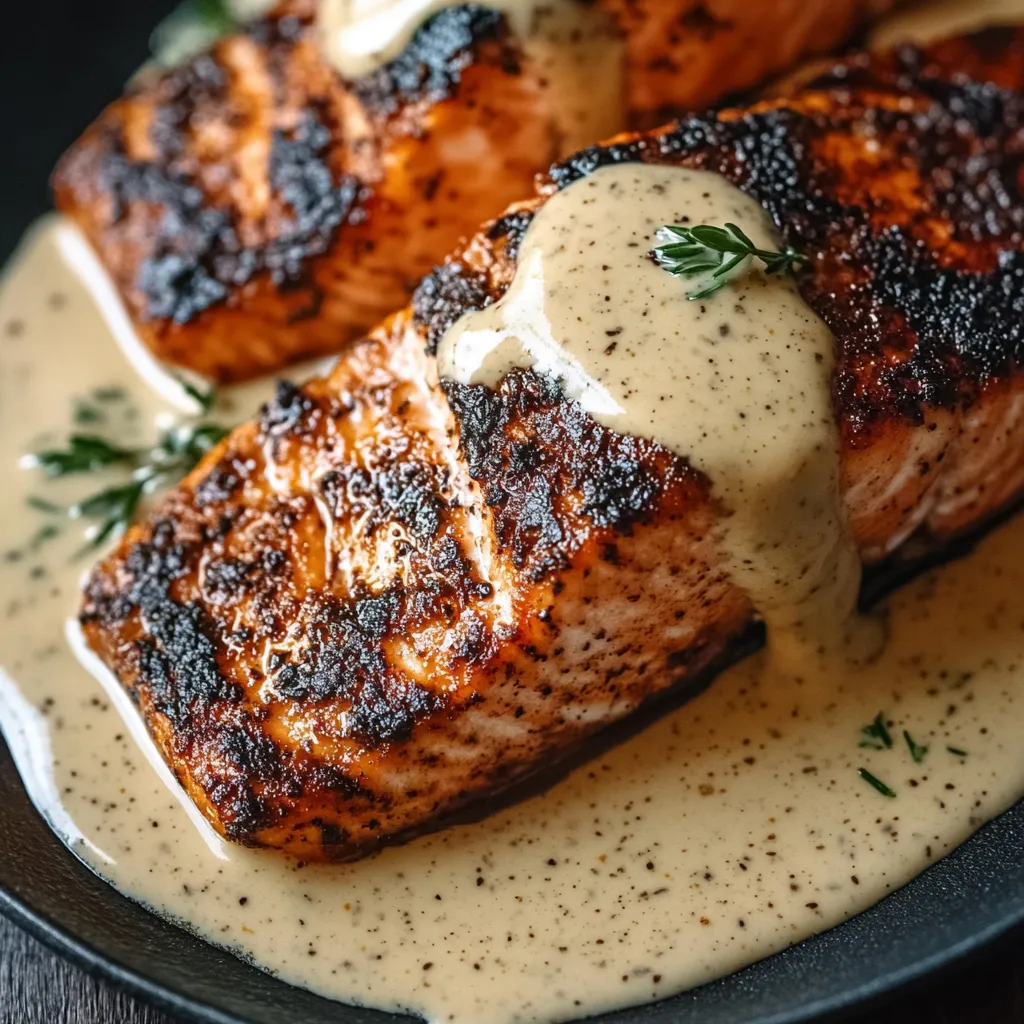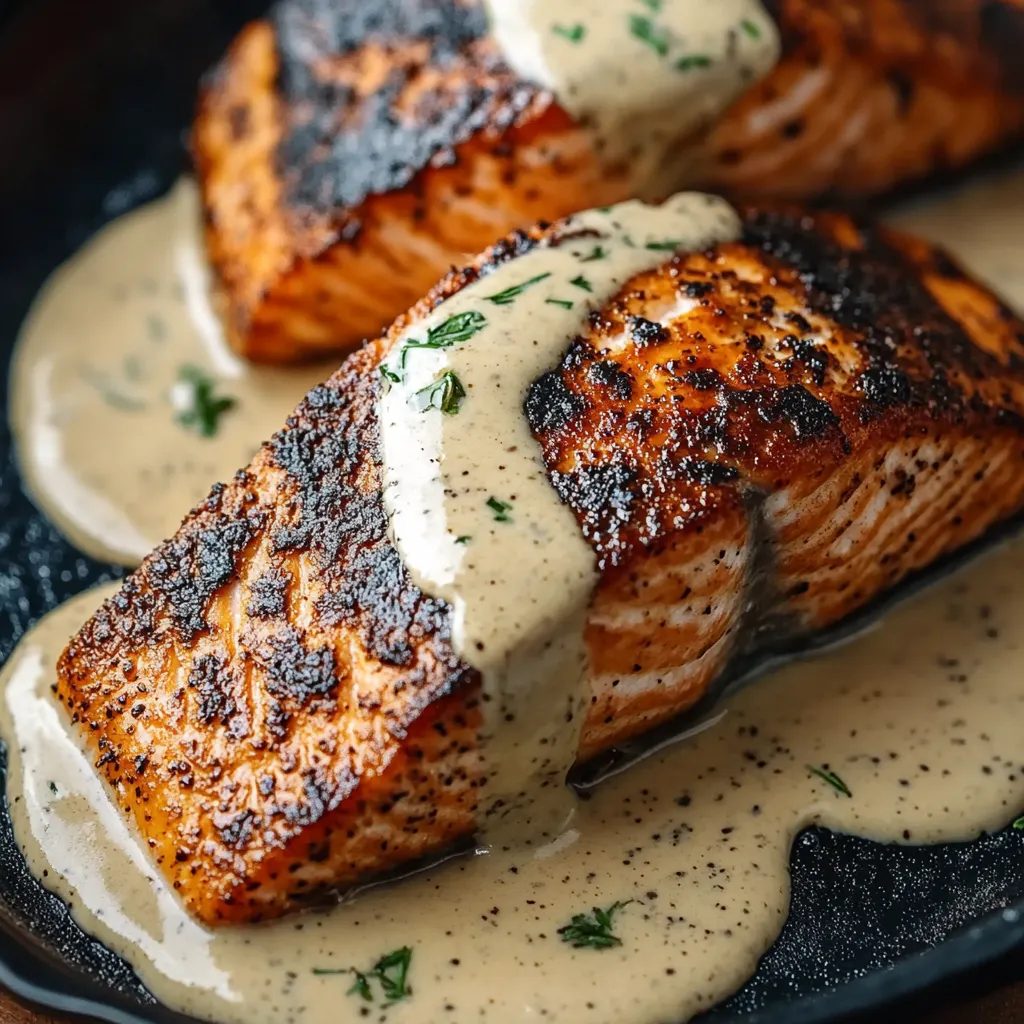 Pin it
Pin it
This blackened salmon with creamy Dijon sauce transforms ordinary weeknight dinner into something truly special without hours in the kitchen. The contrast between the spicy blackened crust and the cool, tangy sauce creates a restaurant-quality dish that never fails to impress guests or satisfy family cravings.
I discovered this recipe during a particularly busy month when I needed quick but impressive dinners. After one bite, my partner declared it the best salmon I'd ever made, and it's been in our regular rotation ever since.
Ingredients
- Salmon fillets: Fresh wild-caught offers the best flavor and texture
- Olive oil: Helps the spices adhere and prevents sticking
- Paprika: Provides that signature deep red color and smoky flavor
- Garlic powder: Adds savory depth without burning like fresh garlic
- Onion powder: Contributes subtle sweetness and umami
- Dried thyme: Brings earthy herbaceous notes
- Dried oregano: Adds Mediterranean flair
- Cayenne pepper: Delivers the heat that defines blackened cooking
- Salt and black pepper: Enhances all other flavors
- Mayonnaise: Creates the rich, creamy base
- Dijon mustard: Provides tangy sophistication
- Lemon juice: Brightens and cuts through richness
- Honey: Balances acidity with gentle sweetness
- Garlic powder: Adds depth without overpowering
- Salt and black pepper: Perfectly seasons the sauce
Step-by-Step Instructions
- Prepare the Blackened Seasoning:
- Combine all dry spices in a bowl until evenly mixed. The uniform blend ensures consistent flavor across the salmon. Take an extra moment to break up any clumps in the spices for the smoothest application.
- Season the Salmon:
- Pat salmon completely dry first this is crucial for achieving a good sear. Apply olive oil evenly over both sides using your fingers or a brush. Press the seasoning mixture firmly onto all surfaces of the salmon. The oil helps the spices adhere and will create that magnificent crust.
- Cook the Salmon:
- Heat your skillet until it just starts to smoke. Place salmon skin side down first this protects the delicate flesh and allows the skin to crisp beautifully. Listen for a satisfying sizzle when the fish hits the pan. Cook undisturbed for 4 minutes before flipping with a fish spatula. The contrast between the blackened exterior and the tender interior is what makes this dish special.
- Make the Creamy Dijon Sauce:
- Whisk all sauce ingredients together until completely smooth and uniform. Taste and adjust seasonings as needed the sauce should be tangy and creamy with a subtle kick from the Dijon and garlic. The cool temperature and creamy texture provide the perfect counterpoint to the hot spicy salmon.
- Serve:
- Plate the salmon immediately after cooking and spoon the sauce generously over the top allow some to pool around the sides. The heat from the salmon will slightly warm the sauce creating an even more luxurious experience.
 Pin it
Pin it
The blackening technique originated in Louisiana Cajun cooking, where Chef Paul Prudhomme popularized it with redfish. I've adapted that technique for salmon because the rich fatty flesh stands up beautifully to the bold spices, creating a more luxurious dish that even people who typically don't love fish tend to enjoy.
Perfect Pairings
Blackened salmon pairs wonderfully with lighter sides that balance its bold flavor. Consider serving it alongside a bright arugula salad with lemon vinaigrette or steamed asparagus. For a more substantial meal, wild rice pilaf or roasted fingerling potatoes make excellent companions. The creamy sauce also works beautifully drizzled over the vegetable sides, tying the whole plate together harmoniously.
Making Ahead and Storage
The blackened seasoning mix can be prepared up to a month in advance and stored in an airtight container. Similarly, the Dijon sauce keeps well in the refrigerator for up to 3 days. For leftover cooked salmon, store in an airtight container separate from the sauce and gently reheat in a 275°F oven just until warmed through, about 10 minutes. The gentle reheating prevents the salmon from drying out, maintaining its moist texture.
Customizing Your Heat Level
The beauty of making your own blackened seasoning is the ability to adjust the heat to your preference. For a milder version suitable for children or those sensitive to spice, reduce the cayenne pepper by half or omit it entirely, substituting with additional paprika. For serious heat lovers, double the cayenne or add a pinch of habanero powder. Remember that the cooling effect of the creamy sauce helps balance even higher levels of spice.
 Pin it
Pin it
This recipe combines ease and elegance for a truly memorable meal. Whether for family or guests, it's sure to be a hit.
Frequently Asked Questions
- → How do I know when the salmon is perfectly cooked?
The salmon is perfectly cooked when it reaches an internal temperature of 145°F (63°C). Visually, the fish should flake easily with a fork but still maintain moisture. The blackened crust should be dark and crispy while the inside remains tender and light pink.
- → Can I adjust the spice level of the blackened seasoning?
Absolutely! You can easily adjust the spice level by changing the amount of cayenne pepper in the seasoning mix. For a milder flavor, reduce or omit the cayenne. For extra heat, increase the amount or add a pinch of chili flakes.
- → Can I make the Dijon sauce ahead of time?
Yes, the creamy Dijon sauce can be prepared up to three days in advance and stored in an airtight container in the refrigerator. This makes meal prep even quicker on busy nights.
- → What sides pair well with this blackened salmon?
This versatile dish pairs wonderfully with roasted asparagus, broccoli, or Brussels sprouts. It's also delicious served over rice, quinoa, or with a side of garlic mashed potatoes. For a lighter option, serve alongside a fresh green salad.
- → Can I use frozen salmon for this dish?
Yes, but for best results, thaw the salmon completely and pat it dry before applying the seasoning. Excess moisture will prevent proper blackening and may cause the spices to steam rather than sear.
- → Is there a dairy-free alternative for the sauce?
Absolutely! You can make a dairy-free version by using vegan mayonnaise as the base for the sauce. All other ingredients remain the same, and the flavor profile will be very similar.
